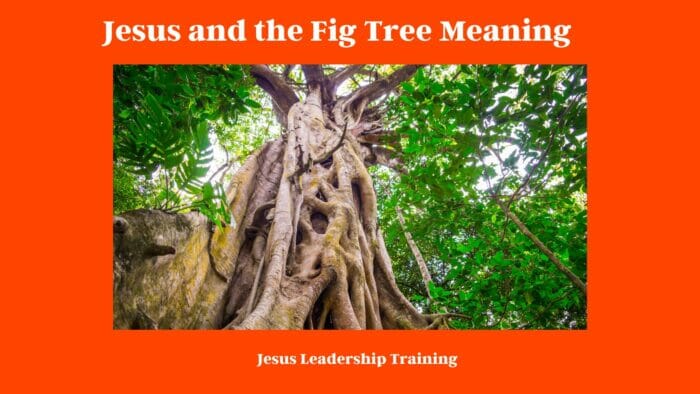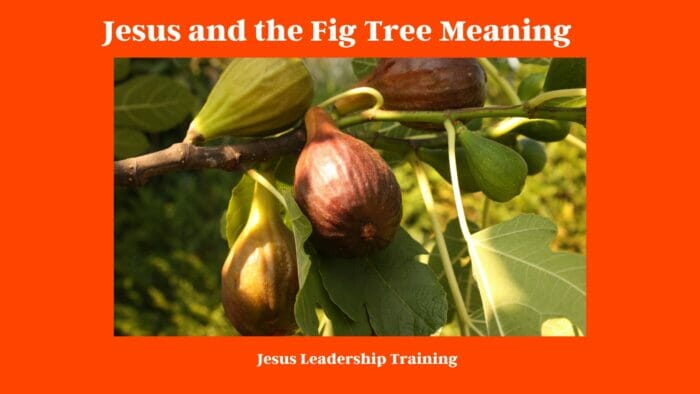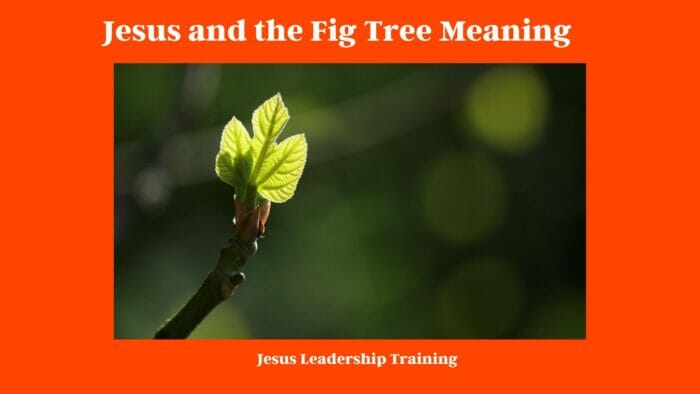Fig Tree in the Bible Symbolism – In the Bible, the fig tree often represents Israel and spiritual life. When Jesus curses a barren fig tree that isn’t producing any fruit, it’s like a living parable warning us about the importance of spiritual “fruitfulness.” Think of it like this: just as the tree wasn’t fulfilling its purpose of bearing fruit, a life without good deeds or spiritual growth is also falling short of its potential.
Jesus is essentially saying that just going through the motions in faith isn’t enough; what’s important is how we embody those beliefs in our actions. So, this isn’t a story about Jesus disliking a tree—it’s about the urgency of living a meaningful, spiritually rich life. Pretty cool, right?
Table of Contents
Fig Tree in the Bible Symbolism
The story of Jesus and the fig tree can seem like a baffling episode in the Bible. It’s not just a moment where Jesus curses a tree; it’s a story filled with layers of meaning that have been discussed, debated, and dissected for centuries.
This article aims to provide a thorough analysis of the event, exploring its symbolism and teachings from various perspectives—Hebrew, Greek, and Aramaic—and even looking into the overall spiritual meaning of fig trees. So, let’s dive in.
Jesus and the Fig Tree Meaning
Unraveling the symbolism in the account of Jesus cursing the fig tree involves looking at it from multiple dimensions. Here’s where we’ll kick off our deep dive.
Meaning in Hebrew
In Hebrew culture, the fig tree often symbolizes Israel and its spiritual condition. When Jesus cursed the fig tree for not bearing fruit, it could be interpreted as a warning for Israel that spiritual barrenness would result in judgment. This judgment can be understood as a metaphor for what could happen when a community loses its spiritual core.

Meaning in Greek
In the original Greek language of the New Testament, the word for “curse” also implies “to doom” or “to destine for ruin.” In Greek culture, the fig tree was not only a symbol of prosperity but also of ethical failure. By cursing the fig tree, Jesus was demonstrating the outcomes of a life that fails to produce good fruit, which is synonymous with a virtuous life in this context.

Meaning in Aramaic
The Aramaic perspective adds another layer of nuance. The word for “fig tree” in Aramaic correlates with “enlightenment.” Therefore, a barren fig tree could signify spiritual darkness or ignorance. Jesus cursing it can be seen as a symbolic rejection of spiritual blindness.
The fig tree is a recurring symbol in the Bible and it serves multiple purposes depending on the context. Here’s a simple table to give you a quick overview:
| Bible Reference | Context | Symbolic Meaning | Summary |
|---|---|---|---|
| Genesis 3:6-7 | Adam & Eve | Covering/Shame | Adam and Eve use fig leaves to cover themselves after realizing they are naked. This signifies a covering for shame. |
| 1 Kings 4:25 | Solomon’s reign | Peace and Prosperity | During Solomon’s time, people “lived in safety, everyone under their own vine and fig tree.” Signifies a time of peace. |
| Micah 4:4 | Messianic prophecy | Future Peace and Prosperity | Similar to 1 Kings, people will sit under their own vine and fig tree, meaning future peace and prosperity. |
| Mark 11:12-14 | Jesus | Spiritual Fruitfulness | Jesus curses the barren fig tree as a lesson about the importance of spiritual fruitfulness. |
| Jeremiah 24:1-10 | Israel | Judgement and Hope | Bad figs symbolize exiles who will face calamity, while good figs represent those who will be preserved. |
| Hosea 9:10 | Israel | Lost Potential | Israel was like a fig tree with early fruit but became corrupt; showing lost potential. |
| Luke 13:6-9 | Parable | Repentance and Second Chances | A fig tree is given one more year to bear fruit after receiving special care, representing God’s grace and patience. |
| Revelation 6:13 | End Times | Judgment | Fig tree dropping its unripe fruit is used as imagery to describe cosmic disturbances and divine judgement. |
So as you can see, fig trees in the Bible are pretty versatile symbols. They can represent everything from shame and covering in Genesis to peace and prosperity during Solomon’s reign and in prophetic visions of the future. They’re also used as powerful lessons about spiritual fruitfulness and God’s judgment. Hope this table helps you get a fuller picture of the many roles fig trees play in the Bible!

Lessons from the Cursed Fig Tree
The tale of Jesus and the fig tree serves as a cautionary parable, offering several lessons we can take away.
The story of Jesus cursing the fig tree found in the Gospels (Matthew 21:18-22 and Mark 11:12-14, 20-25) has puzzled many, but it also offers various spiritual lessons. Here’s a table breaking down some of those teachings:
| Lesson | Explanation | Application |
|---|---|---|
| Spiritual Fruitfulness | Jesus expected the fig tree to bear fruit and was disappointed to find it barren. This symbolizes the importance of producing good deeds or “fruits” in our spiritual life. | Evaluate your own life for spiritual “fruits” like kindness, patience, and love. Are you living in a way that is spiritually fruitful? |
| Timeliness | Even though it was not the season for figs, the tree gave the appearance of being fruitful because it had leaves. The lesson here is about being ready and fruitful in all seasons. | Always be ready to act in ways that reflect your values, regardless of the circumstances. |
| God’s Expectations | God has expectations of us, much like Jesus had expectations of the fig tree. Failure to meet those expectations may result in loss or judgment. | Be aware of what God expects from you and strive to live up to those expectations. |
| Power of Faith | After the tree withers, Jesus talks about the power of faith and how genuine belief can move mountains. | Trust in your faith and its power to create change. Prayers and faith can lead to miraculous outcomes. |
| Importance of Prayer | Jesus uses the opportunity to teach about the importance of prayer and the need to forgive others when we pray. | As you pray for your needs, also remember to forgive those who have wronged you; it’s a package deal according to Jesus. |
| Consequences of Hypocrisy | The fig tree, with its leaves but no fruit, could be seen as a hypocrite: all show and no substance. This serves as a warning against spiritual hypocrisy. | Authenticity in your beliefs and actions is essential; don’t just “talk the talk,” but also “walk the walk.” |
I hope you find this table helpful for understanding the multi-faceted lessons we can draw from the story of Jesus cursing the fig tree. It’s a rich narrative that has been interpreted in various ways, offering insights that are still incredibly relevant today!

How Many Times is Fig Tree Mentioned in the Bible
The fig tree is mentioned 55 times throughout the Bible. Each mention carries its own significance, ranging from representing prosperity to spiritual ineffectiveness. This repetition underlines the importance of understanding the fig tree’s multifaceted symbolism.
Fig Tree Bible Verse
The main account can be found in Mark 11:12-14, and Matthew 21:18-22. These passages offer not only historical data but also, more importantly, spiritual lessons about faith and judgment.
Spiritual Meaning of the Fig
In broader biblical terms, the fig tree symbolizes more than just Israel or spiritual barrenness. It is often seen as a representation of life, fertility, and prosperity. When the fig tree is fruitful, it signifies a spiritually rich and fulfilled life.
When did Jesus Curse the Fig Tree
According to the Gospel of Mark, the incident occurred the day after Jesus’ triumphal entry into Jerusalem. It holds a significant place in Holy Week, between Palm Sunday and Good Friday.
Why did Jesus Curse the Fig Tree: A Catholic Perspective
In Catholic thought, Jesus’ action is viewed as a “living parable.” It serves as a lesson on the fruits of faith and the consequences of spiritual barrenness. It’s not so much about the tree but what it represents in our own lives.
The story of Jesus cursing the fig tree is one of those intriguing moments in the Bible that leaves many people scratching their heads. 🤔 Why would Jesus, known for His love and kindness, do such a thing to a tree? Well, let’s dig into some of the reasons behind this act:
Symbolic Judgment
The fig tree, especially when barren, was often used as a symbol for Israel’s spiritual barrenness. By cursing the tree, Jesus was symbolically showing the judgment that would come upon Israel for not producing the “fruits” of righteousness.
Teachable Moment
Jesus used the fig tree as an object lesson for His disciples. It served as a vivid, memorable example to teach about the power of faith and the consequences of not living up to one’s God-given potential.
Indictment Against Hypocrisy
The tree had leaves but no fruit, which could be seen as a form of false advertising. Similarly, Jesus was condemning the outward religiosity of the leaders of His day that produced no real spiritual fruit.
Divine Expectations
The fig tree was created to bear fruit, and its failure to do so made it subject to judgment. This mirrors the expectations God has for His people to produce good works as evidence of their faith.
Illustration of Power
By causing the tree to wither immediately, Jesus demonstrated His authority over creation, providing a tangible example of His power to His disciples.
Impending Destruction of the Temple
The act foreshadows the coming destruction of the Temple in Jerusalem, another “fruitless tree,” which had become a den of robbers instead of a house of prayer, according to Jesus.
Call to Repentance
Ultimately, the act served as a warning and a call to repentance, encouraging people to produce the spiritual fruits of love, justice, and righteousness.
So there you go! The story isn’t just about a fig tree having a particularly bad day; it serves multiple symbolic and educational purposes. Hope this clears up some of the mystery
Jesus Fig Tree Parable
The parable is a lesson about the importance of spiritual readiness. When Jesus found the tree barren, he cursed it, just as those who are spiritually barren may be turned away from entering the Kingdom of Heaven.
Fig Tree Spiritual Meaning
Moving away from biblical accounts, the fig tree holds considerable symbolic importance in various cultures and beliefs.
Fig Leaf Symbolism
The fig leaf is often associated with modesty and concealment, as it was the leaf Adam and Eve used to cover themselves in the Garden of Eden.
Fig Symbolism in Art
In art, the fig tree is typically a symbol of abundance, but also of enlightenment and knowledge, tying back to its biblical roots.
Figs and fig leaves have made quite the impression in biblical stories and subsequently, in religious art inspired by the Bible. Below is a table that outlines some key instances where figs and fig leaves are featured, either literally or symbolically, in biblical art.
| Biblical Story | Artistic Element | Significance in Art | Common Artistic Representations |
|---|---|---|---|
| Adam and Eve in the Garden of Eden | Fig Leaves | Used to cover the nakedness of Adam and Eve after they gain knowledge of good and evil. Symbolizes vulnerability, shame, or enlightenment. | Paintings and sculptures often show Adam and Eve covering themselves with fig leaves. |
| Jesus Cursing the Fig Tree | Barren Fig Tree | Represents spiritual barrenness and serves as a warning about the consequences of failing to bear ‘spiritual fruit.’ | Often depicted with a withered tree near Jesus, emphasizing the power of His words. |
| The Promised Land | Figs | Figs, along with other fruits, symbolize the prosperity and fertility of the Promised Land. | Figs are sometimes included in depictions of biblical landscapes or in art illustrating the bounties of the Promised Land. |
| Song of Solomon | Fig Tree | Represents fertility, love, and abundance. Often used metaphorically in the poetic dialogue. | Occasionally featured in art that tries to capture the essence or scenes from this poetic biblical book. |
Art inspired by the Bible often includes these elements to add layers of meaning, interpret the original text, or emphasize certain themes. Whether you’re an art aficionado or just casually interested, recognizing these elements can enrich your understanding of both the Bible and the art it inspires. Isn’t it fascinating how a simple fruit or leaf can carry so much weight in the world of religious art?
Myths about Fig Trees
In some cultures, fig trees are considered sacred, while in others, they’re thought to be a home for spirits and demons. These myths often carry their own lessons and morals.
Are Fig Trees Good Luck
In many Eastern traditions, the fig tree is seen as a symbol of good luck and prosperity, often planted with the hope that it will bring blessings to the home.
Final Thoughts 🌟Jesus and the Fig Tree Meaning
Unpacking the story of Jesus and the fig tree isn’t just an exercise in biblical studies; it’s an exploration of deep spiritual, ethical, and cultural lessons. Whether you’re a believer or a seeker, understanding the layers of meaning in this story can offer valuable insights into life’s bigger questions.
The story of Jesus cursing the fig tree is a rich narrative found in the New Testament, specifically in the Gospels of Matthew and Mark. It’s often discussed because of its complex symbolism and the lessons it offers. Here are some major points about Jesus’ teaching with the cursed fig tree:
- Expectation of Fruitfulness: Jesus approaches the fig tree expecting to find fruit, even though it’s not the season for figs. This sets the stage for the lesson on spiritual fruitfulness.
- Consequence of Barrenness: When Jesus finds the tree barren, He curses it. This serves as a warning about the consequences of not bearing “spiritual fruit” in one’s life.
- Immediate Impact: The tree withers away quickly, demonstrating the immediate impact of Jesus’ words and serving as a tangible representation of spiritual death due to fruitlessness.
- Lesson in Faith: After cursing the tree, Jesus tells His disciples that if they have faith and do not doubt, they can not only do what was done to the fig tree but also perform even greater acts, like moving mountains.
- Connection to Temple Cleansing: In Matthew, the fig tree episode is sandwiched around the story of Jesus cleansing the Temple in Jerusalem. This serves to connect the barrenness of the fig tree with the spiritual barrenness Jesus finds in the Temple.
- Jewish Symbolism: The fig tree was a common symbol for Israel and the Jewish people. So, in cursing the barren fig tree, some scholars interpret Jesus as commenting on the spiritual state of Israel at the time.
- Eschatological Undertones: Some interpretations suggest that the story carries a message about the end of times, acting as a warning to be spiritually prepared, as one does not know when their time to bear fruit will come to an end.
- Moral Responsibility: The cursed fig tree is often seen as highlighting the moral responsibility of every individual to live a fruitful life, full of good deeds and spiritual commitment.
- Power of Words: The story also showcases the incredible power that words can hold, emphasizing the potent combination of faith and speech.
- Deeper Than Surface Appearances: The tree had leaves but no fruit, serving as a caution against superficiality in one’s spiritual life. It’s a reminder that looking the part isn’t enough; one must also bear fruit.
So, there you go! Jesus’ interaction with the fig tree is a multi-layered teaching moment that has been analyzed and interpreted in numerous ways. It serves as a compelling lesson in faith, morality, and the consequences of our actions or inactions. Pretty deep for a story about a tree, right?
Frequently Asked Questions
- What does the fig tree symbolize in the Bible?In the Bible, the fig tree often symbolizes Israel, prosperity, and spiritual life.
- Why did Jesus curse the fig tree?Jesus cursed the fig tree as a living parable to demonstrate the consequences of a life that fails to produce spiritual fruit.
- How does the fig tree story fit into the life of Jesus?The story takes place during Holy Week, serving as a transitional event between Jesus’ triumphal entry into Jerusalem and His crucifixion.
Other Resources
- Here are some websites that you can use to learn more about Jesus:
- BibleProject: BibleProject is a non-profit animation studio that produces short-form, fully animated videos to make the biblical story accessible to everyone, everywhere. They believe that the story of Jesus has the power to transform people and entire communities. You can explore the theme of the city throughout the story of the Bible—from the first city built by Cain to the final garden city in the new creation. They also offer free tools to study the story of the Bible.
- Christianity.com: Christianity.com is a website that offers a wide range of resources for Christians, including articles, videos, podcasts, and more. You can learn all about the life of Jesus from his birth in Bethlehem to his death and resurrection. Discover the truths about the Son of God who became the Savior of the world. Get biblical answers to common questions many people have about Christ our Savior.
- Britannica: Britannica is a trusted source for information on a wide range of topics, including Jesus. Their website offers a comprehensive overview of Jesus’ life and teachings, including his miracles, death, and doctrines.
- LoveToKnow: LoveToKnow is a website that provides information on various topics, including Christianity. They have compiled a list of some of the best Christian websites available online. Some of these websites include CrossWalk, Bible Knowledge, Turn Back to God, and Jesus.org. I hope this helps! Let me know if you have any other questions. 😊
Best Bible Encyclopedias and Dictionaries
Below is a table featuring some highly regarded Bible Encyclopedias and Dictionaries along with their publishers and websites where they can be found or purchased.
| Title | Publisher | Website |
|---|---|---|
| The International Standard Bible Encyclopedia | Eerdmans | Eerdmans |
| Zondervan’s Pictorial Bible Dictionary | Zondervan | Zondervan |
| Easton’s Bible Dictionary | Thomas Nelson | Thomas Nelson |
| Holman Illustrated Bible Dictionary | B&H Publishing Group | B&H Publishing Group |
| The New Unger’s Bible Dictionary | Moody Publishers | Moody Publishers |
| HarperCollins Bible Dictionary | HarperOne | HarperOne |
| Vine’s Complete Expository Dictionary of Old and New Testament Words | Thomas Nelson | Thomas Nelson |
You can generally find these resources on the publishers’ websites, as well as other online book retailers such as Amazon or Christianbook. It’s always good practice to confirm availability and review additional details on the specific websites or other reliable online bookstores.





